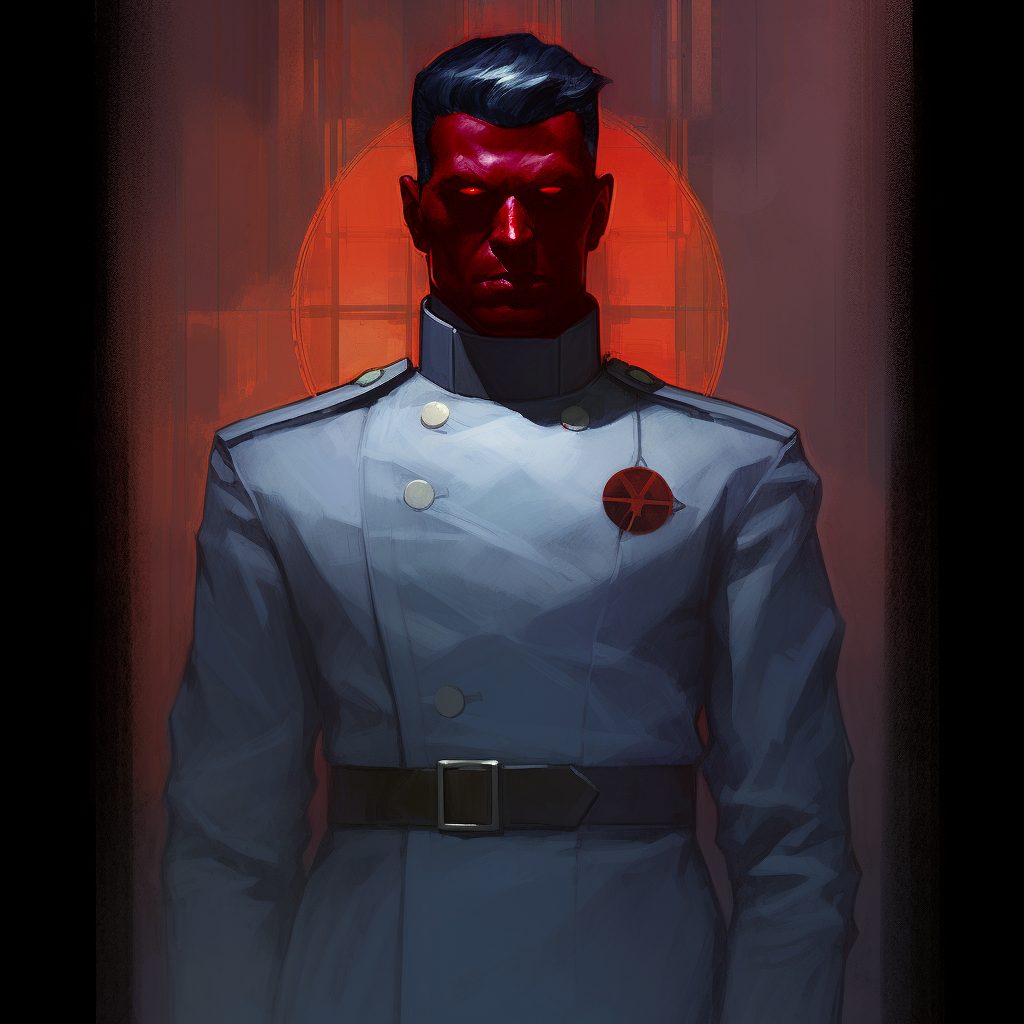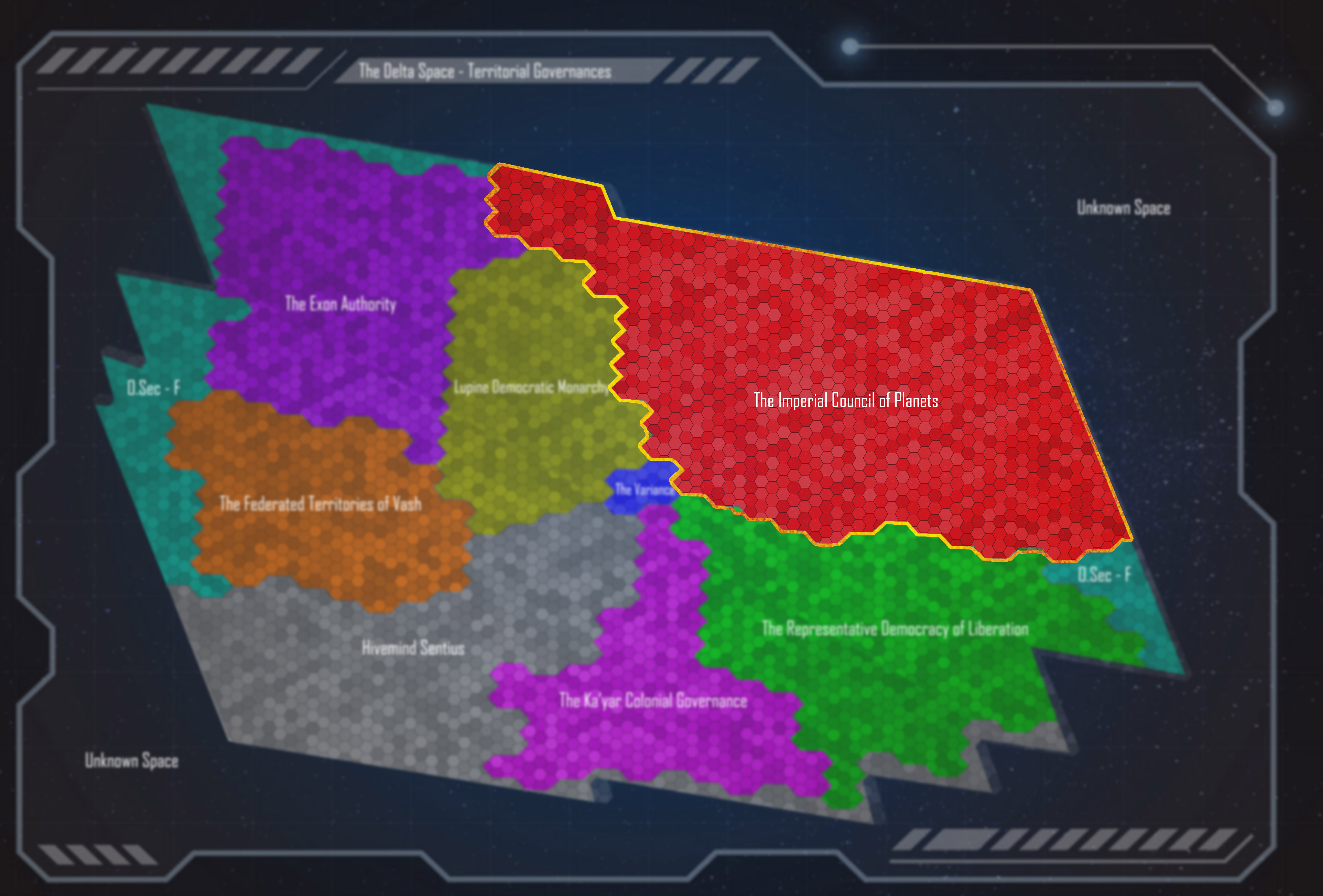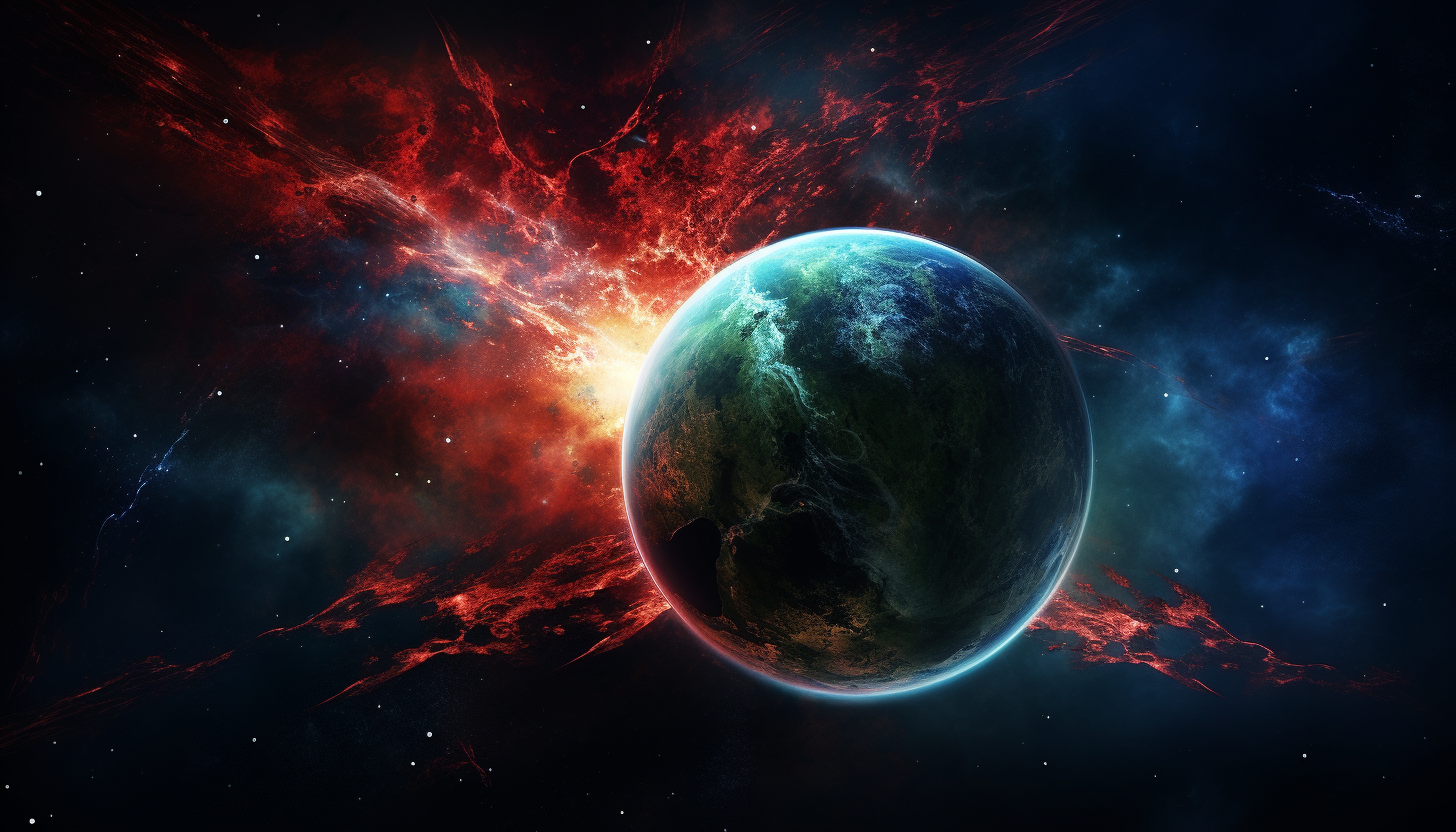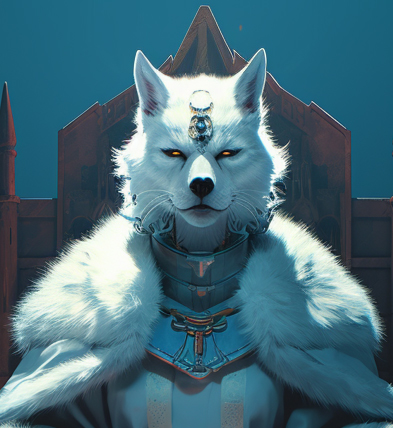The Imperial Council of Planets
From Founders to Conquerers — Origins of The Imperials
The force that would eventually become the Imperial Council of Planets arrived in the Delta Space over 3,000 years ago. Among the original group of Founders, their primary goal was to map and settle within the area. At the time, they were simply Founders — one of many thousands seeking a place to call home among the stars.
A group of like-minded Founders soon gathered, weary of wandering aimlessly, and settled on what would later be known as Phorbaceus Imperia in the Founders’ Era Galactic Calendar Year of 142.
Originally called Bufo and populated by the amphibian Bufon race, the planet offered a temperate and comfortable environment. In the early years of cohabitation, the two races lived in relative peace, with minimal interaction. However, as the Imperial Founders’ population grew, their ideology shifted, and their desire for expansion placed the Bufon on a path toward extinction. Now, thousands of years later, the Bufon are a marginalized minority on the Imperial Council of Planets' capital world, nearing extinction.
The fate of the Bufon was an early indicator of the Imperial Founders’ future trajectory. Over the next several hundred years, the Imperial Founders adopted a heavily militaristic ideology, forming their stratocracy and initiating an aggressive campaign to colonize surrounding territories. This expansion quickly annexed hundreds of planets, establishing the Imperial Founders as the most powerful and expansionist Territorial Governance in the Delta Space nearly 1,000 years before any other major nation.
During this era of aggressive expansion, two key developments occurred that shaped the Imperial Founders’ current physical and mental forms.
Rapid Evolution:
Under mysterious circumstances, the Imperial Founders underwent sudden and rapid evolution, becoming physically enhanced and increasingly aggressive. They are now recognized as an official offshoot of the original Founders, called the Imperial Founders. This sudden and dramatic change is often touted as the main driving force behind the Imperial's aggressive tendencies and obsession with territorial expansion. (see The Imperial Founders and Forcer Evolution sections for more details) Conflict with the Lupine Democratic Monarchy:
The second critical event was the Imperials’ first military defeat and the start of their ongoing rivalry with the Lupine Democratic Monarchy. Located to the west of Imperial space, the Lupine are a steadfast and proud race of Lupine humanoids. Having existed in the Delta Space far longer than the Founders, the Lupine have fostered a deep connection with their territory and people. Early interactions between the Lupine and Imperials led to fierce resistance from the Lupine, who opposed Imperial territorial encroachment. To this day, the two factions engage in relentless conflict, refusing trade or diplomacy. The rivalry has resulted in a constant state of hostility, with borders repeatedly contested over centuries. While the Lupine historically maintained open borders with their neighbours, the expansion of the Imperial Founders forced the Lupine — and nearly every other governing power in the Delta Space — to establish firm territorial boundaries. Although these borders have shifted over time, the Imperial colonization efforts ignited countless years of territorial disputes throughout the region. The only other nation to establish firm borders before the Imperial Founders was the Ka’yar Colonial Governance. Even they have experienced shrinking territories under pressure from their former allies in the Representative Democracy of Liberation. Today, the Imperial Council of Planets stands as the most powerful military force in the Delta Space. Their armada includes an enormous fleet of warships, a near-endless supply of weaponry and technology, and numerous specialized units such as the Imperial Protection Federation (IPF), tasked with enforcing law and order across interplanetary Imperial territories.
Imperial Council of Planet territory, highlighted in yellow
A Military Oligarchy - The Imperial Stratocracy (Government)
The Six Segments of the Imperial Control Council
Segment Bellatorum
Defence and WarfareResponsible for overseeing the empire's vast military forces, including fleets, ground armies, and advanced weapons development. This is arguably the most powerful segment and leadership position to hold outside of becoming the Imperial Emperor, in fact, many Defence and Warfare Consuls have become Emperor over the vast stretch of the Imperial Stratocracy's existence. Current Leader - Bellatorum Consul Cassian Merex, a stoic man renowned for his cunning installer warfare knowledge, he is the current rival to the current Imperial Emperor and is earmarked to take over that role if Imperial Emperor Lucian Vyrex is ever deposed.
Segment Justicarum
Law and OrderEnforces imperial law, oversees military tribunals, and maintains internal security. This segment of the government is the only one that deals with internal security and protection affairs, including the Imperial Protection Federation, which serves as the governance citizen police force. If an internal issue arises that puts any segment of government or those involved within it in danger, the Segment Justicarum will involve itself and ensure the issue is dealt with. Current Leader - Justicarum Consul Kyra Luceris, a harsh but fair individual who holds great loyalty to the emperor and the Imperial Stratocracy.
Segment Praevisum
Intelligence and ReconnaissanceManages covert operations, intelligence gathering, and counter-espionage efforts across the Delta Space. Unsurprisingly they are the most secretive of the branches of the government, often having to keep their operations hidden from the rest of the Imperial Control Council. Even the Imperial Emperor doesn't know everything they are up to. Current Leader - Praevisum Consul Selis Par, a surprisingly charismatic and chatty individual known for their ability to expertly extract information from even the most tight-lipped of individuals. Many of the other Consuls distrust Par and avoid them unless necessary.
Segment Economica
Resource Management and LogisticsControls resource allocation, interplanetary trade, and the empire's war economy. This segment of the government works more closely with the rest than any other, as they are the ultimate authority when it comes to who gets what, including funding. Current Leader - Economica Consul Aurel Vantor, an unsurprisingly shrewd and pragmatic administrator who is not easily swayed and only releases funds and resources towards what they feel is absolutely necessary. Is close to the current Bellatorum Consul Cassian Merex.
Segment Scientifica
Research and Technological AdvancementOversees scientific research, technological innovation, and development of advanced weaponry and infrastructure. The Scientifica has dozens, if not hundreds, of ongoing experiments at any given time. They often bend the rules of morality in order to attain what they believe will benefit the Imperial force. The scientists of the Scientifica are rumoured to be working on the Imperials' next evolutionary step. Current Leader - Scientifica Consul Kallus Bree, a visionary scientist who has led many of the Imperial Council of Planets' most innovative advancements in recent years. Bree is unafraid to conduct morally dubious experiments if it means the ultimate advantage for the Imperials as a whole. He has even been rumoured to have experimented on himself.
Segment Ordinatum
Civil and Colonial AffairsManages civil administration, interplanetary governance, and the integration of conquered worlds. Likely the busiest of all segments of government, the Ordinatum must ensure that all planets both well-established and newly integrated into the Imperial Council of Planets has the resources they need. Often times the Ordinatum fails in this due to a lack of resources and many integrated planets do not have all they require. Current Leader - Ordinatum Consul Tiber Quorax, a frantic individual who is often overwhelmed by the many tasks at hand. Often comes into conflict with the Economica Consul Aurel Vantor over funds and resource availability. The council has been less than impressed with Quorax, and their current status on the Imperial Control Council is in jeopardy.
The Imperial Emperor
Imperial Emperor Lucian Vyrex
Phorbaceus Imperia — capital of the Imperial Council of Planets
Imperial Protection Federation (I.P.F)
Complicated Relationships - Partnerships and Rivals
Partnership with the Ka’yar Colonial Government
This agreement has established a favourable trade and travel arrangement between the two major powers. In particular, it grants the Imperials significantly greater access to the Ka’yar’s vast reserves of ignition crystals — a resource highly valued and sought after by all governing bodies.
In return, the Imperial Council of Planets has agreed to assist in the Ka’yar's war effort against the Representative Democracy of Liberation. The Imperials have deployed numerous warships to pressure the Representative Democracy of Liberation's northern border, hoping that forcing them to split their forces will weaken their defences and break their resolve.
Endless Rivals: The Lupine Democratic Monarchy
One notable exception is the noble and iron-willed Lupine of the Lupine Democratic Monarchy, located along the Imperial Council of Planets’ western border. Since their first encounters with the Imperials many generations ago, the Lupine have steadfastly resisted any attempts at westward expansion into their historic territory.
From their earliest interactions, the Lupine have pushed back against Imperial encroachment, and to this day, the two powers remain locked in frequent and bitter conflict. They do not trade, they do not negotiate, and they do not engage diplomatically. They only fight. Even in moments of uneasy peace, both sides remain on the brink of renewed hostilities.
Loyalists - Imperial General Populace
Summary
The Imperial Council of Planets is one of the largest expanses of controlled territory in the Delta Space, they currently control the entire northeastern expanse of mapped space in the region. Commonly known as the Imperials, this geopolitical entity is highly militaristic, controlling the largest army in all the Delta Space, even rivalling the Ka'yar Colonial Governance. The Imperials run their section of space as a specialized form of Oligarchy called a Stratocracy — which is a form of government organized in a similar fashion as a military and is lead by military chiefs.
The Imperials are the most dangerous force in the Delta Space when it comes to firepower and control over their borders. It is rare for a territory to win back space once it has been taken by the Imperials, though there have been exceptions — which has been the case with the Imperials' rivals to the west in the Lupine Democratic Monarchy.
The Imperials have very few friends in the Delta Space, having made enemies of all of their neighbours at some point or another in their history. Even the allies they currently have are tenuous and only kept due to the potential gain it may provide. Including their current allyship with the Ka'yar Colonial Governance, fighting against the Representative Democracy of Liberation — they only hold this alliance due to the promise of access to the Ignition Crystal trade. Beyond this the Imperials are happy to do business with the evil collection of MegaCorpos throughout the Delta Space, doing whatever benefits them without care for how it affects the general populace.
The Imperial populace of the territory and generally quite loyal, having been heavily brainwashed since their youth. However, the vast collection of inherited citizens from the mass selection of planets the Imperials have conquered over the years feel quite different about their current overlords. However, any thoughts of rebellion are quickly stamped out.
Other than the Hivemind Sentius, they have the longest uninterrupted border with the unpredictable region known as Unknown Space, even the greedy conquerors of the Imperial Council of Planets have been smart enough to stay away from.The empire retains its name, the Imperial Council of Planets, to emphasize continuity and legitimacy despite its autocratic structure. The planets under its dominion are rarely represented within the upper echelons of power, reflecting a governance model that prioritizes central authority over local representation. This enduring imperial identity underscores the stratocracy’s intent to project order and dominance across its territories.
Naming the Empire
Race - The Imperial Founders
Tiber Kalix, an Imperial Founder and CECO of WhiteStar Militech








Comments